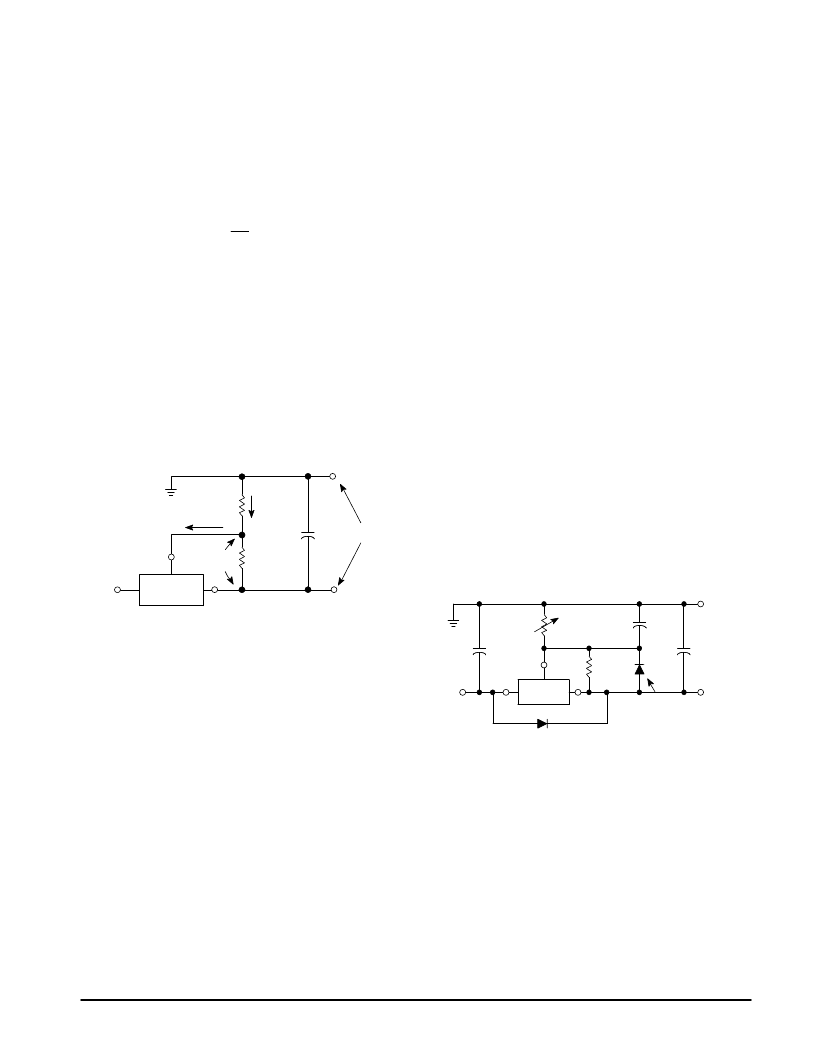- 您現(xiàn)在的位置:買賣IC網 > PDF目錄358842 > LM337MT (ON SEMICONDUCTOR) MEDIUM CURRENT THREE-TERMINAL ADJUSTABLE NEGATIVE VOLTAGE REGULATOR PDF資料下載
參數(shù)資料
| 型號: | LM337MT |
| 廠商: | ON SEMICONDUCTOR |
| 元件分類: | 基準電壓源/電流源 |
| 英文描述: | MEDIUM CURRENT THREE-TERMINAL ADJUSTABLE NEGATIVE VOLTAGE REGULATOR |
| 中文描述: | 1.2 V-37 V ADJUSTABLE NEGATIVE REGULATOR, PSFM3 |
| 封裝: | PLASTIC, POWER PACK-3 |
| 文件頁數(shù): | 7/8頁 |
| 文件大?。?/td> | 158K |
| 代理商: | LM337MT |

LM337M
7
MOTOROLA ANALOG IC DEVICE DATA
APPLICATIONS INFORMATION
Basic Circuit Operation
The LM337M is a three–terminal floating regulator. In
operation, the LM337M develops and maintains a nominal
–1.25 V reference (Vref) between its output and adjustment
terminals. This reference voltage is converted to a
programming current (IPROG) by R1 (see Figure 17), and this
constant current flows through R2 to ground. The regulated
output voltage is given by:
R2
R1
Vout = Vref (1 + ) + IAdj R2
Since the current into the adjustment terminal (IAdj)
represents an error term in the equation, the LM337M was
designed to control IAdj to less than 100
μ
A and keep it
constant. To do this, all quiescent operating current is
returned to the output terminal. This imposes the requirement
for a minimum load current. If the load current is less than this
minimum, the output voltage will rise.
Since the LM337M is a floating regulator, it is only the
voltage differential across the circuit which is important to
performance, and operation at high voltages with respect to
ground is possible.
+
–
Vout
CO
R2
IPRONG
R1
IAdj
Adjust
Vin
LM337M
Vout
+
Vref = –1.25 V Typically
Vref
Figure 17. Basic Circuit Configuration
Load Regulation
The LM337M is capable of providing extremely good load
regulation, but a few precautions are needed to obtain
maximum performance. For best performance, the
programming resistor (R1) should be connected as close to
the regulator as possible to minimize line drops which
effectively appear in series with the reference, thereby
degrading regulation. The ground end of R2 can be returned
near the load ground to provide remote ground sensing and
improve load regulation.
External Capacitors
A 1.0
μ
F tantalum input bypass capacitor (Cin) is
recommended to reduce the sensitivity to input line
impedance.
The adjustment terminal may be bypassed to ground to
improve ripple rejection. This capacitor (CAdj) prevents ripple
from being amplified as the output voltage is increased. A
10
μ
F capacitor should improve ripple rejection about 15 dB
at 120 Hz in a 10 V application.
An output capacitance (CO) in the form of a 1.0
μ
F
tantalum or 10
μ
F aluminum electrolytic capacitor is required
for stability.
Protection Diodes
When external capacitors are used with any IC regulator it
is sometimes necessary to add protection diodes to prevent
the capacitors from discharging through low current points
into the regulator.
Figure 18 shows the LM337M with the recommended
protection diodes for output voltages in excess of –25 V or
high capacitance values (CO > 25
μ
F, CAdj > 10
μ
F). Diode D1
prevents CO from discharging thru the IC during an input
short circuit. Diode D2 protects against capacitor CAdj
discharging through the IC during an output short circuit. The
combination of diodes D1 and D2 prevents CAdj from
discharging through the IC during an input short circuit.
+
–
+
Cin
–Vin
R2
CAdj
+
+
1N4002
LM337M
Vout
Vout
Vin
D1
1N4002
R1
D2
CO
Adjust
Figure 18. Voltage Regulator with
Protection Diodes
相關PDF資料 |
PDF描述 |
|---|---|
| LM3403 | Quad Operational Amplifiers |
| LM3403N | Quad Operational Amplifiers |
| LM3403M | Quad Operational Amplifiers |
| LM3403J | Quad Operational Amplifiers |
| LM340AT-12 | THREE-TERMINAL POSITIVE FIXED VOLTAGE REGULATORS |
相關代理商/技術參數(shù) |
參數(shù)描述 |
|---|---|
| LM337SP | 功能描述:線性穩(wěn)壓器 - 標準 1.2-37V Adj Negative RoHS:否 制造商:STMicroelectronics 輸出類型: 極性: 輸出電壓:1.8 V 輸出電流:150 mA 負載調節(jié): 最大輸入電壓:5.5 V 線路調整率: 最大工作溫度:+ 125 C 安裝風格:SMD/SMT 封裝 / 箱體:SOT-323-5L |
| LM337SP | 制造商:STMicroelectronics 功能描述:V REG ADJ -1.2/37V TO-220-3 337 |
| LM337T | 功能描述:線性穩(wěn)壓器 - 標準 1.5A Neg Adj Vol Reg RoHS:否 制造商:STMicroelectronics 輸出類型: 極性: 輸出電壓:1.8 V 輸出電流:150 mA 負載調節(jié): 最大輸入電壓:5.5 V 線路調整率: 最大工作溫度:+ 125 C 安裝風格:SMD/SMT 封裝 / 箱體:SOT-323-5L |
| LM337T | 制造商:Texas Instruments 功能描述:V REG ADJ -1.2/37V TO-220-3 337 |
| LM337T/ELLI802 | 制造商:Texas Instruments 功能描述: |
發(fā)布緊急采購,3分鐘左右您將得到回復。